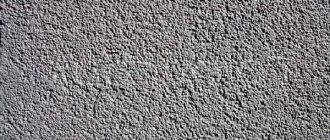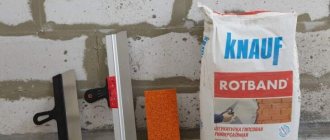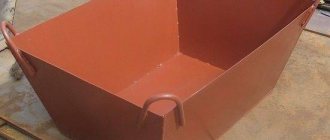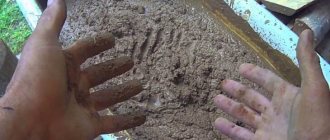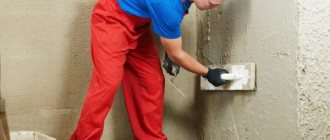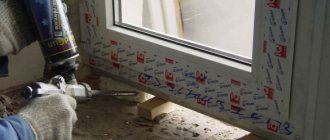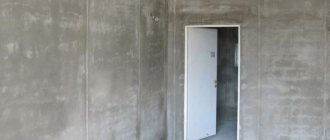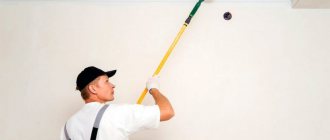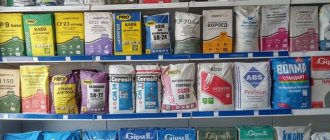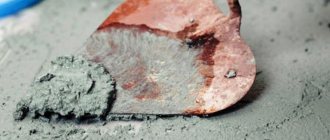Plastering walls and ceilings is an important stage of finishing work. The facing coating performs the functions of protection, decoration and additional insulation, perfectly hides seam joints and corrects minor defects in masonry. Strength and durability depend on the correct ratio of the components of the solution.
Types of cement mortars
The basic composition of any plaster always remains the same: binder, filler and water. The choice of binder depends on the nature of the finishing work (external/internal) and operating conditions (wet/dry microclimate). It can be cement, clay, lime, gypsum. Quarry or river sand is most often used as a filler. Sawdust, perlite, fine slag, and granulated polystyrene are less common. The filler ensures the strength and smoothness of the layer.
In practice, cement mortars are most often chosen for finishing external and internal walls; they are characterized by increased strength and durability. The technological feature is slow (about 12 hours) setting. To change the quality characteristics, it is combined with other binders. The proportions of the main elements in the composition of the plaster determine its performance indicators.
There are the following types:
1. Cement-sand – composed of cement, sand and water. It is used for façade plastering of walls and plinths in conditions of high humidity. Inside the house it is well suited for the bathroom, toilet, kitchen.
2. Cement-lime - prepared in the same way as the first one, only liquid diluted lime is added instead of water. Used for finishing the exterior and interior of the building.
3. Cement-clay is an excellent solution for indoor walls with moderate humidity. Can only be used outside in dry climates.
Composition and proportions of cement-based plaster solutions
Brand is a conditional concept that depends on many factors. It is determined on a test bench within 28 days. A small cube of hardened plaster is taken as a sample, which is tested for compression. The permissible degree is adjusted by changing the ratio of the binder component and filler.
This complex procedure is more applicable on an industrial scale of construction. In everyday life, finishing mortar is prepared based on the brand of cement. So for one part of M400, 4 parts of sand are taken, for M500 - 5 parts. This simple rule gives average indicators of the ratio of the constituent elements.
| Kinds | sprinkling | primer layer | fine finishing |
Proportions of cement-sand plasters
Proportions of cement-lime mortars
The ratio of components of the cement-clay mixture
By changing the proportions, you can strengthen or weaken the strength. If, when using the M500 brand, you choose a ratio of 1:4, you will get a strong mixture that is suitable even for laying walls. Increased strength entails an increase in the density of the plaster layer, and this completely changes the technical performance of the cladding.
Heavy dense plasters have increased thermal conductivity and water resistance. They are best used for facade cladding of buildings. Light solutions (M500 1:6 and higher) show a decrease in frost resistance, so they are suitable for interior work.
Features of the use of dry mortars for plaster
Multicomponent mixtures for wall finishing are often found on the building materials market. They are produced on the basis of Portland cement grade M400 or M500. Contains polymer additives that enhance ductility, improve adhesion (sticking to the working surface) and increase strength.
- Reducing the weight of the structure - when finishing the facade, reinforcement with steel mesh is not required.
- Cost-effective – the master spends a minimum of effort and time for mixing. In addition, the consumption of the finished mixture is much less than a solution prepared independently.
- Durability – responds gently to changing weather conditions. Thanks to plasticizers, it does not crack under sudden temperature changes.
- Moisture and vapor permeability – a normal microclimate is maintained inside plastered rooms.
Dry building mixtures are developed in laboratory conditions, and therefore differ in the exact proportions of the components, homogeneity and readiness for use.
Features of homemade and ready-made building mixtures
Ready-made plaster mixtures are not cheap, which is explained by the correct proportions of all components. In addition, in addition to the base, the composition includes various additives to give the coating the appropriate qualities. These are frost resistance, moisture resistance, increased adhesion, hardening period, etc.
Many finishers find it easier and more familiar to work with such materials than with homemade analogues. Customers prefer to use traditional mixtures, since their cost is significantly lower. Especially when it comes to large-scale work. In turn, homemade solutions can also be endowed with the necessary characteristics by adding simple components.
Types of plaster
The purpose of the final product affects the ingredients used and their ratio:
- To treat external walls, a composition of cement, lime and sand is created. The same composition is suitable for coating interior walls in wet areas, for example, in showers, bathrooms, and basements.
- If the expected indoor or outdoor humidity level is low, plaster is made from cement, sand, clay and gypsum.
- There is a special composition for medium humidity levels. Clay and cement are added to it.
Technology for determining the “average thickness of the plaster layer”
So-called “key points” or “beacons” are attached over the entire area of the wall to be plastered, which are set according to the level. These can be nails, self-tapping screws, screws or special strips. The rule here is “the more beacons, the more accurate the calculation.” In general, there should be at least three “key points” located over the entire wall area.
Linear measurements of the depths of the recesses are made, which in one place of the wall can be 5 cm, in another 2 cm, and in a third 6 cm. The measurements of irregularities are summed up, after which their average value is calculated.
Proportions of cement and sand for plastering walls
The proportions of the components described above depend on many factors. The table below shows the main points that need to be monitored to achieve a good final product.
| cement | 1 | 1 | 1 |
| sand | 2,5-4 | 2-3 | 1,5-2 |
| Portland cement | 1 | 1 | 1 |
| lime | 0,3-0,5 | 0,7-1 | 1-1,5 |
| sand | 3-5 | 2,5-4 | 2,5-4 |
| cement | 1 | ||
| clay | 4 | ||
| sand | 6-12 | ||
Conditions
| Proportions (cement to sand, parts) | Comments | |
| Regular composition, without special restrictions and conditions | 1:5 | When mixing the composition, add water to achieve the desired consistency. The volume of water is also important for obtaining a quality product and is therefore added gradually. |
| Fatty composition for coating walls after spraying | 1:3 | Spraying is the preparation of walls for the application of plaster. This is a preliminary stage of working with concrete walls. A liquid solution, which includes cement and sand, is applied to the wall, previously moistened with water. |
| Cover layer | 1:1 | The covering is the third layer of creamy plaster. It is applied to the primer (second layer), which was applied to the first layer - spray. |
When we talk about a “part” of components, we mean any container. It can be a bucket, or a shovel, or a ladle. It is important to stick to the container once chosen throughout the entire preparation to avoid mistakes.
With a plaster layer thickness of 20 mm or more, per 1 sq.m. On average, the surface requires 6 kg of cement, 20 kg of sand, if the proportion is 1:4.
The table below demonstrates the interdependence on the composition of the plaster and the required proportion of components used:
| Type of solution | Spray | Priming | Covering |
| Calcareous (lime:sand) | 1:(2,5-4) | 1:(2-3) | 1:(1-2) |
| Cement (cement:sand) | 1:(2,5-4) | 1:(2-3) | 1:(1-2) |
| Clay (clay:sand) | 1:(3-5) | 1:(3-4,5) | – |
| Lime-clay (lime:clay) | 0.2:(1-3) | 0.2-(1-5) | 0.2:(1-3) |
| Lime-gypsum (lime: gypsum: sand) | 1:1:2 | 1:0.5:2 | 1:1:5 |
| Clay-gypsum (clay: gypsum: sand) | 1:0.2:3 | 1:0.2:3 | – |
Consumption rate
Before starting work, it is necessary to calculate the consumption of the required material. Material consumption rates per 1 m2 of wall depend on the composition of the mixture and the condition of the surface.
By type or manufacturer
Per square meter of improved plaster, 0.0189 is required, and for high-quality plaster, 0.0255 cubic meter of solution is required.
Products from one of the manufacturers
There is a large selection of ready-made mixtures on the market from well-known manufacturers: Knauf, Bergauf. There are also materials from other manufacturers. The most popular compositions with modifying additives and water-repellent properties are produced by Knauf, Bergauf, Hercules.
How to prepare plaster correctly
The production of plaster mortar is not limited to maintaining the required ratio. Equally important is how exactly the composition is prepared. Technology must be strictly followed.
The following tips will help you do everything right.
- Each dry component (sand, lime) must be passed through a special sieve before it is added to the mixture.
- Excess components are no less harmful than deficiencies. Any deviation from the ideal proportion will degrade the quality of the final product.
- An important parameter for the quality of plaster is fat content. Its degree is determined by the instrument used to mix the composition during preparation. If the mixture sticks to it, it means it has a high degree of fat content. To return to balance, sand is added - it reduces fat content. If the composition does not stick at all, then it is skinny. The adhesion will be poor, and to improve it, binders are added. Good plaster sticks to the tool, but not too much.
A greasy mixture means that more cement was taken than needed. The composition turned out to be too thick, it will be difficult to adhere to the walls. The mixture is considered lean if, on the contrary, too little cement was taken. The result of such an error is high composition turnover.
The mass becomes normal when it is easy to apply to the surface and stays there for a long time.
Flaws
Despite the high qualities of walls and ceilings treated with gypsum material, it has some disadvantages that should be taken into account when further working with it.
Disadvantages of building gypsum composition:
- A high degree of moisture absorption, which allows the use of this material to be limited - only in dry rooms.
- It is prohibited to use gypsum composition on surfaces with metal elements, since due to high moisture absorption the metal is subject to corrosion.
- Low strength characteristics.
These mixtures have a high cost among similar finishing materials. As a result, the consumption of any type of gypsum plaster is calculated in advance.
Incorrect calculations of the thickness of the layer of applied finishing material can lead to their overestimated thickness. A layer of mixture that is too thick does not have the necessary strength and may fall off under its own gravity.
Specifications
Plaster for different needs
Any plaster mixture contains cement, the portions of which depend on many reasons. In addition to the viscous component, other components may be present in the plaster:
- sand;
- slaked lime to improve the material’s resistance to moisture and increase its volume;
- gypsum to speed up the drying of the leveling layer on the surface
- water;
- detergent (liquid soap, washing powder) for the elasticity of the finishing mass.
The listed materials are used to improve the quality of cement paste for surface finishing.
Leveling mortar is used on walls to prepare the basis for finishing. The composition should be thick and adhere well to the surface.
If the proportions of the plaster solution are incorrect, it may be thin or excessively thick. Of course, it is possible to refine the solution, but it is better not to waste time and do everything correctly.
Modern finishing trends make it possible to use paste as a finishing decoration for walls inside the house and for the facade. The decorative composition is usually sold ready-made. The ratio of cement and sand is calculated by experts. All that remains is to add color.
Important! You can prepare a solution for leveling the surface yourself if you buy all the substances separately and follow the correct recipe. In fact, this method is cheaper than buying a ready-made mixture in a store. Let's understand the intricacies of dosing sand, water, cement in the finished mass. Photos are enlarged, click!
Characteristics
The choice of cement plaster composition for walls is determined by the following features:
- characteristics of the base;
- method of application;
- quality of the applied mixture.
According to the purpose of application, the compositions are divided into categories:
- simple, eliminating irregularities and defects in the base;
- special, containing additives to impart the necessary properties;
- decorative, or finishing, used for finishing.
Cement plaster is widely used and can withstand climatic conditions outside and inside the house.
Surface structure before finishing
Correct recipe
Cement mortar for plastering walls is considered a classic material, which different finishers prepare according to their own recipe. By trial and error, they adopted a certain ratio of components, which the master follows unconditionally. Exceptions arise only in situations where it is necessary to change the main ingredients due to the lack of the necessary ones.
But there are standards regulating the proportions of plaster mortar. They can be used at home.
The ratio of sand and cement for plaster is determined by the labeling of the substance and the purpose of the composition.
- for exterior finishing, cement marked M 400 , less often M 500, ;
- indoors - M100 , M200 .
When mixing the finishing mixture for walls yourself, the proportions of the substances are determined by the container:
You cannot change the selected item because the proportions will be incorrect.
- The classic ratio of sand and cement is 4:1, where there are 4 portions of sand and one portion of cement.
- For wet rooms or building facades, the composition is mixed in a ratio of 2:1 or 3:1, respectively, a large portion of sand and a smaller portion of cement.
- If brand M 500 , the proportion of sand is increased by one dose.
Important! For a high-quality mortar, the main factors are not only the proportions of cement and sand for plastering walls, but also the amount of water that is poured into the mixture. The finished solution resembles thick sour cream. But there is a classification of the leveling mass, which depends on the dosage of the astringent:
- fatty mixture - the proportion of cement to another substance is greater than the standard, the composition turns out thick, settles quickly, and is more difficult to lay on the base;
- lean mass - the proportions of cement are reduced, which increases the fluidity of the material along the plane;
- normal weight - the binder/filler ratio is within normal limits, which makes it easier to apply to any wall.
Important! A simple way to determine the amount of cement for wall plaster is to study the instructions on the packaging of the ready-made mixture in the store. Using the ratio of plaster ingredients from the package, it is easier to understand what the paste should be for leveling or decorating walls inside or outside a building.
Let's look at the photo:
Knauf Rotband
“Rotband” is a popular, affordable and high-quality gypsum mixture, optimal for application by hand. The thickness of the layer should not exceed 5 cm. The amount required to treat 1 m2 with a layer of 1 cm is 8.5 kg.
Buy Knauf Rotband in the online store
Anton Tsugunov , I have been doing repairs and finishing since 2003.
I prefer to buy plaster in an online store - it is very simple, convenient and safe. You can buy plaster without leaving your home. Most often I order delivery directly to the site, so as not to waste time and not “damage” the car.
In the online store you can find the exact specifications and real customer reviews.
Moreover, when I pay for the tiles with my card , I receive cashback of up to 30% of the purchase amount!
It turns out to be a double benefit! I don’t risk my health, I don’t waste time on the road, I receive the paid tiles at the time I specified and also save up to 30%.
Plaster is packaged in 30, 10 and 5 kg
